Odyssey: The Mentor Matchmaker
“Mentoring can be a great way to share knowledge and help someone be successful in their personal or professional life. But many potential mentors are often too busy to commit to regular meetings, or they have a hard time connecting with people seeking help. Design an experience where prospective mentors and mentees can be matched, based on similar interests, location, and availability. Show your process and how you arrived at your solution. Please include a sequence of high-fidelity mocks from your design solution.”
What follows is my response to this prompt. Time on task is approximately 20 hours.
Initial thoughts, questions and assumptions
I began with everything I knew, or thought I knew, about mentoring and the relationship between mentor and mentee.
Who is the mentor, what type of person are they? What motivates them? And who is the mentee, or protégé? What are they looking for, why is it difficult to find?
How is a decision made to start a mentoring relationship? There might be trust barriers when meeting potential matches outside of a workplace context.
And mentoring, unlike tutoring, is often done for free, so without a financial exchange, why does one do it? Why does one become a mentor?
What is the transaction? What is the reward?
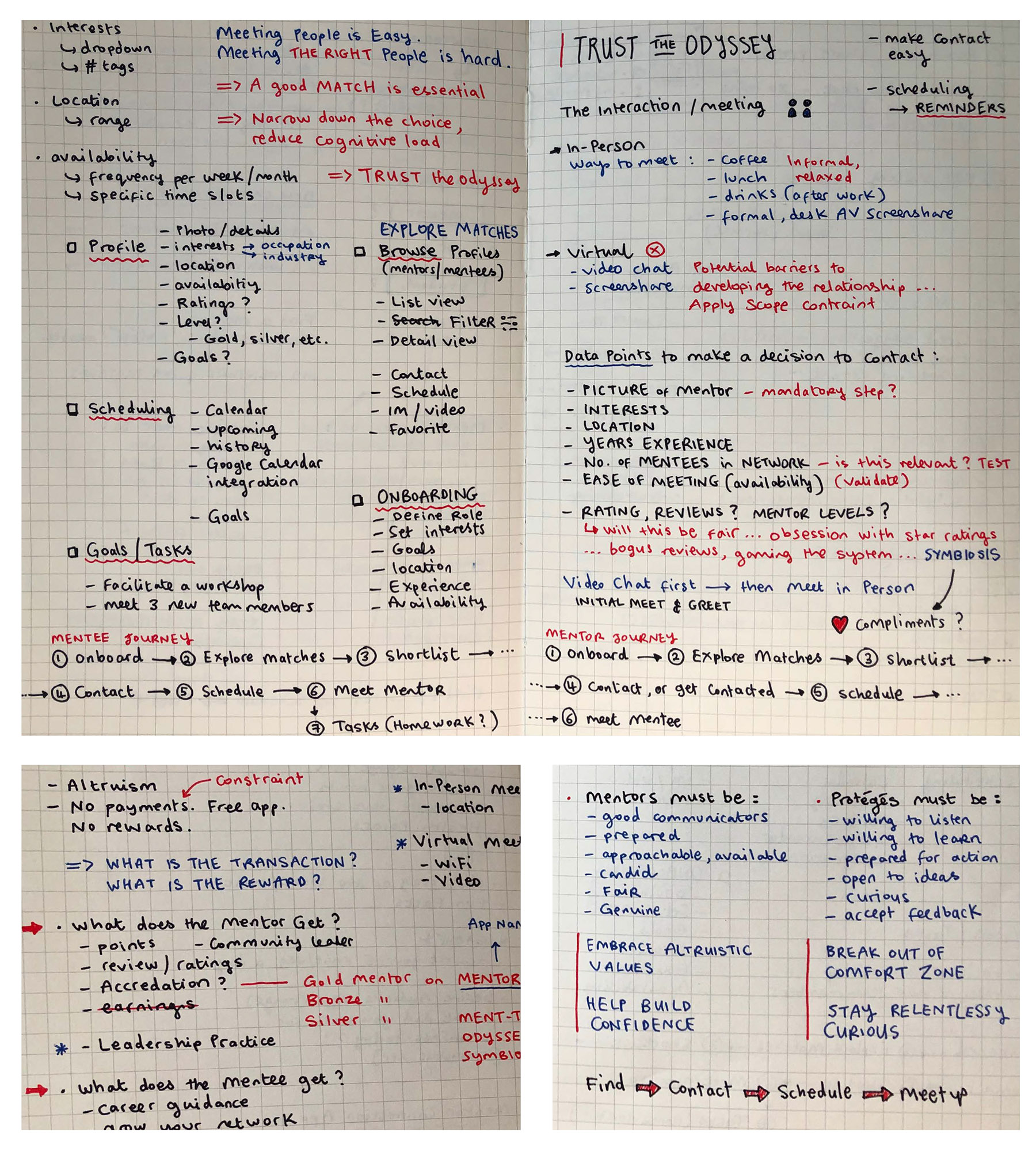
Interviews – Start with Why
Having been both a mentor and a protégé myself, I could empathize fairly well with both perspectives. But I needed more data.
Surveys are a great way to get quantitative data. The results are valuable, but often impersonal. I favor the intimacy of one-on-one interviews to truly inspire my design insights. Real feedback, from real people, doing real things.
So to broaden my understanding of the issues at hand, I interviewed several friends and former colleagues to hear first-hand about their experiences in a mentoring relationship; the common goals, behaviors, frustrations and rewards.
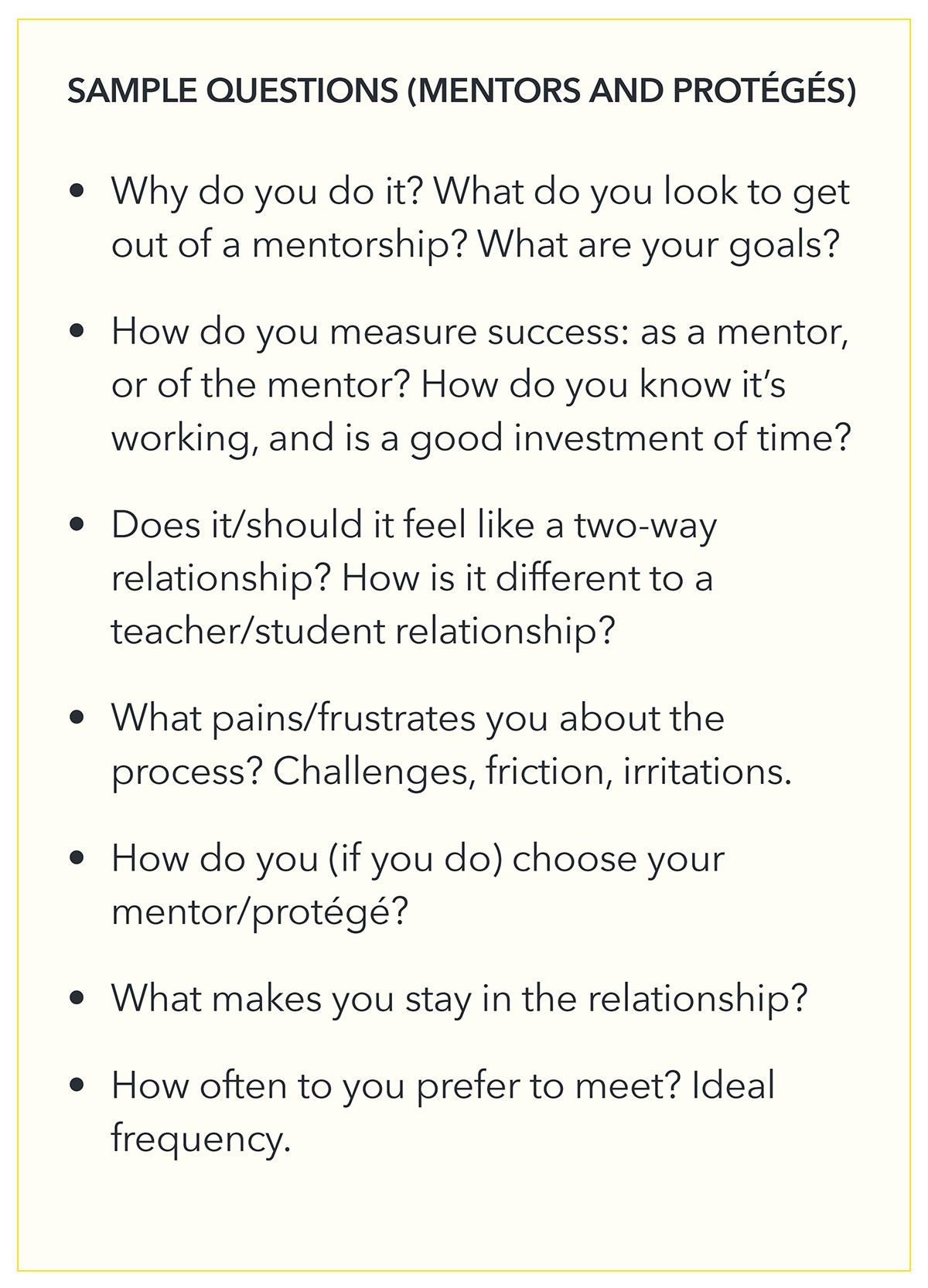
Meeting people is easy. Meeting the right people is hard.
Sharon, protégé
Symbiosis is crucial to sustain engagement. Both parties should be getting something out of the relationship.
Vikrim, mentor
Research Insights
Through further research and discovery, I formed a picture of the underlying problems that needed solving in designing this experience, and solutions to focus on.
PROBLEM
Connections can be difficult to make, and they are often not a good match, so mentorships suffer and fail.
SOLUTION
Make connecting with the right people easy. The ‘right people’ are those that are a compatible match to you, and that will result in a fruitful relationship for both parties.
PROBLEM
If the relationship does not have comparable rewards for both parties, committing to the process may be a challenge.
SOLUTION
Symbiosis is crucial. It must be a two-way transaction. You both have to want it. The time invested in this relationship should be rewarding for both parties in order to be successful. People are more likely to commit time and energy into rewarding and fruitful relationships.
PROBLEM
There might be trust barriers to overcome when it comes to meeting a suggested match outside of a work environment.
SOLUTION
Break down trust barriers with peer reviews and legitimize profiles with additional information, e.g. resume details, social presence. Contact via instant messaging and video prior to meeting in person.


MISSION STATEMENT
Facilitate meaningful connections between mentors and protégés.
We will do this by:

Designing an experience where compatible protégés and mentors respectively invest their time into the initial connection, resulting in more valuable relationships.

Capitalizing on the respective motivations of both the mentor and the protégé by only allowing contact if both parties express interest in each other.

Encouraging the next steps in the relationship with quick contact options and ease of scheduling.
Competitive Analysis
I always look at experiences in the wild in considering potential features for my designs. What do others do that works well? Where could I improve? What is it that will make my solution break through the noise? The question is what separates connections that sustain from ones that fade away? Good connections are about compatibility, trust and symbiosis. Compatibility is informed by preferences. Trust encourages engagement. Symbiosis ensures the relationship will flourish.
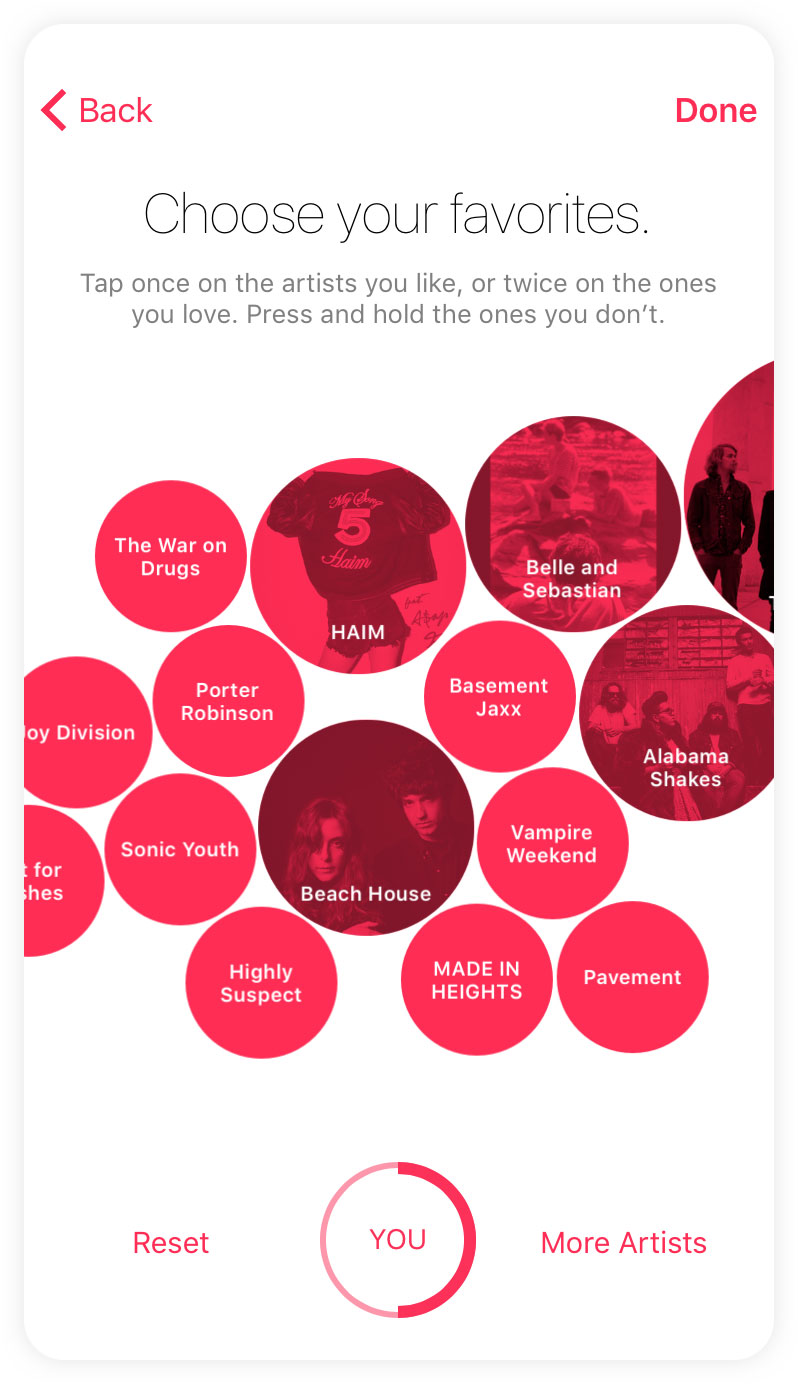
iTunes Music: onboarding
Set your preference. Help us help you.
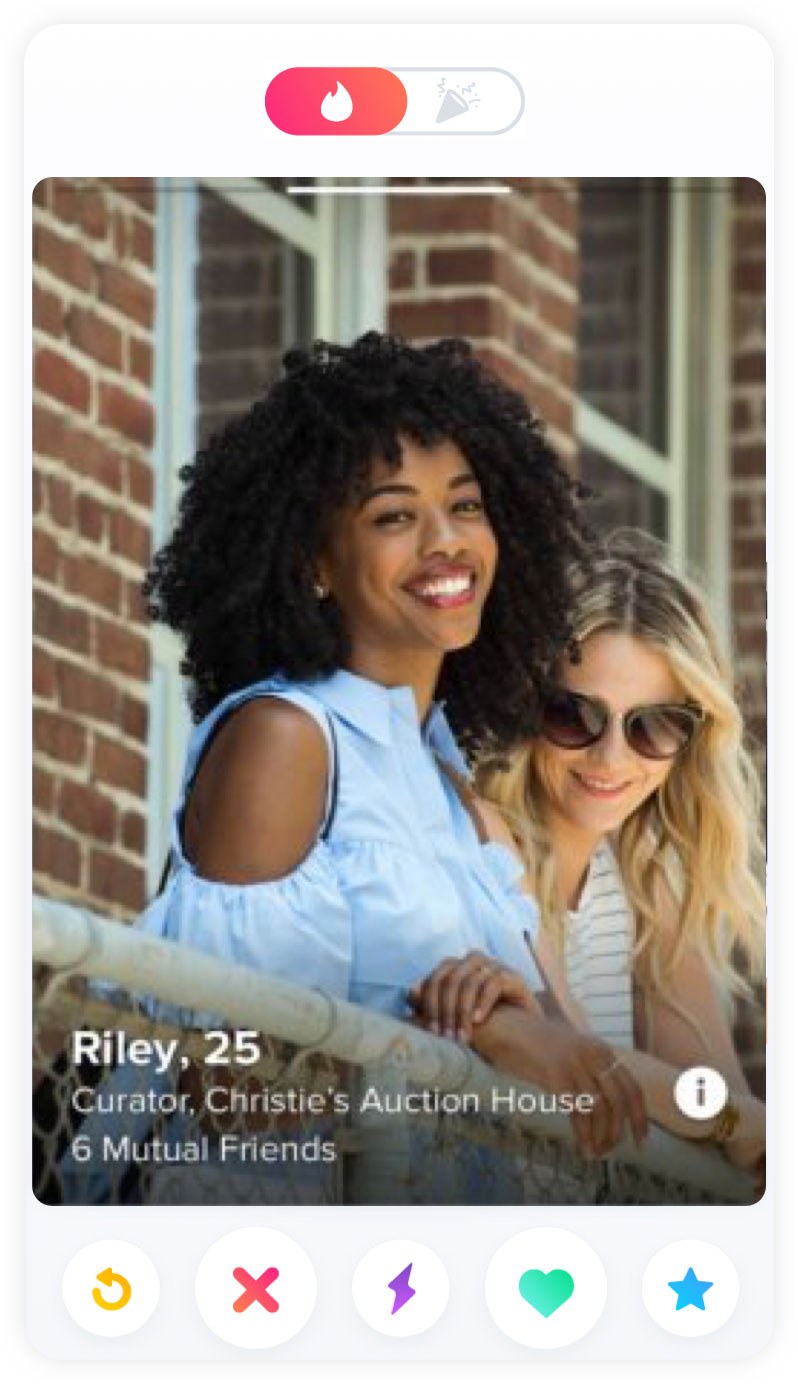
Tinder: swipe right
Compatibility. A good first impression.
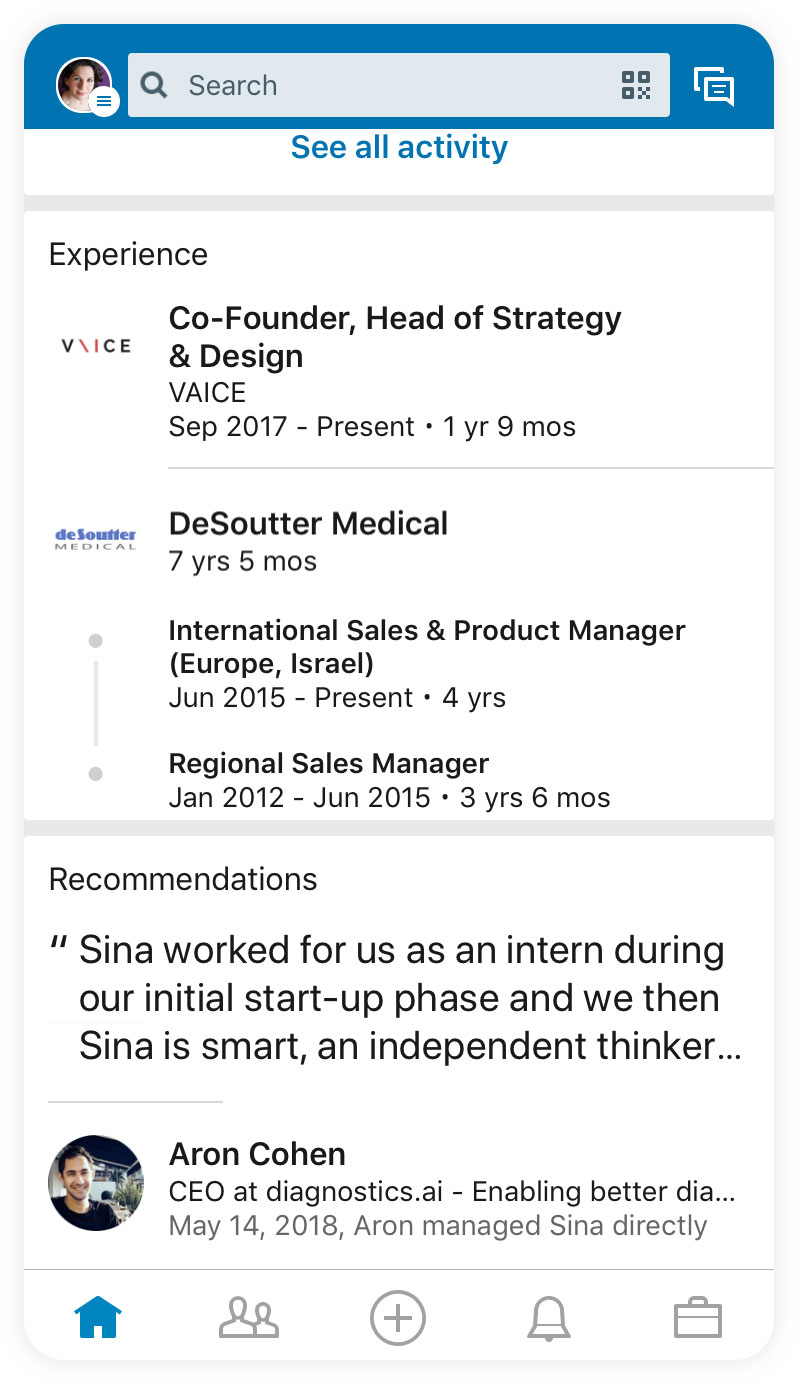
LinkedIn: connections
Resumes, kudos. Frequent cold calling; one-way contact.
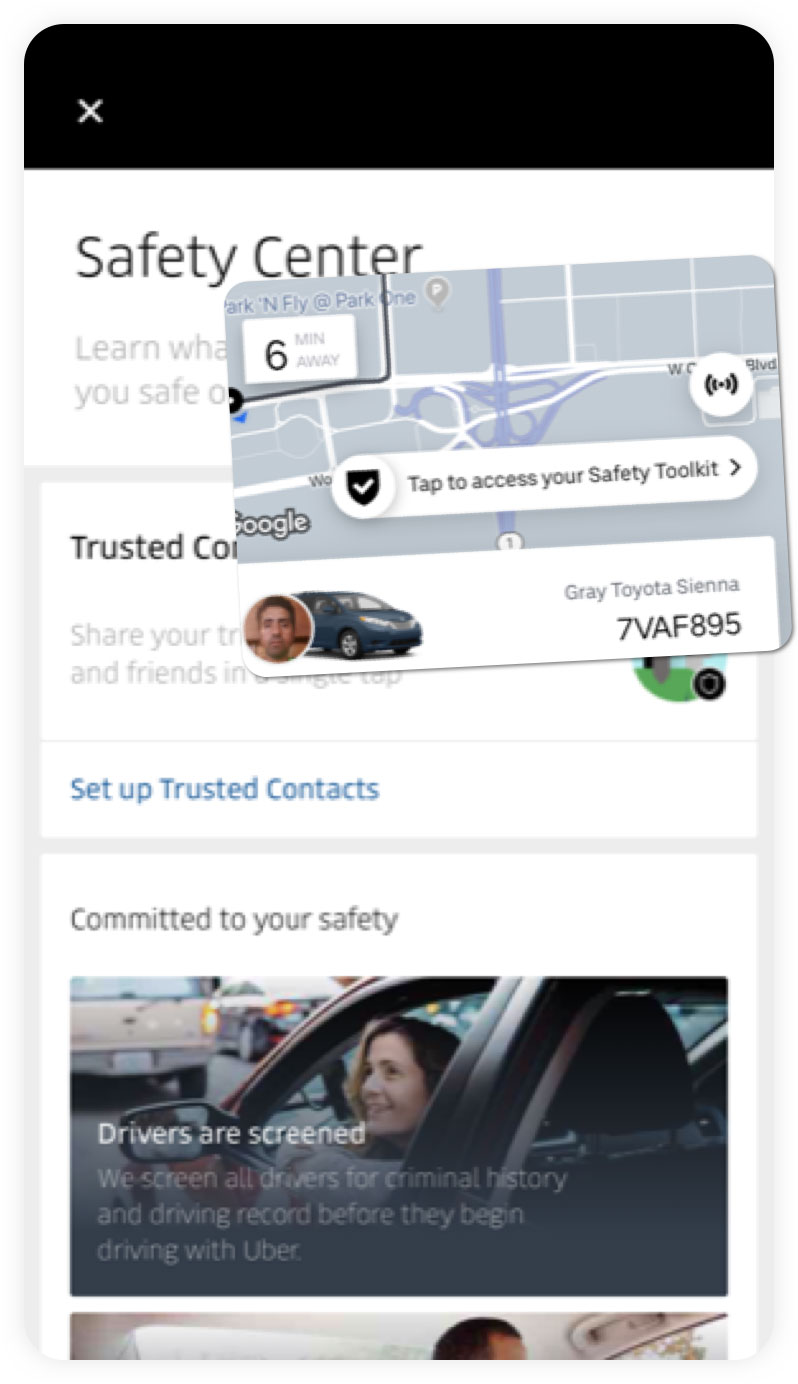
Uber: safety concerns
Trust. Of the service. And the people using it.
This is not LinkedIn, and it’s not Tinder; but it just might be somewhere in between.
Additional analysis: Amazon, Yelp, ZocDoc, OpenTable, AirBnb, Mentor Meet, Fiverr, Shapr, PushFar.
Sketching the Solution
I now had a good idea of the features, desired actions and necessary data points I would need to solve the problem, so I set about sketching some key user flows in the experience, and considered a few options for the architecture. Working first by hand in my notepad and on whiteboards, I then moved to Sketch to refine the flows and create some wireframes. I also wanted my solution to have a catchy name. I decided on Odyssey, after the character Mentor in Homer’s epic poem The Odyssey, from which the term mentor is said to derive.
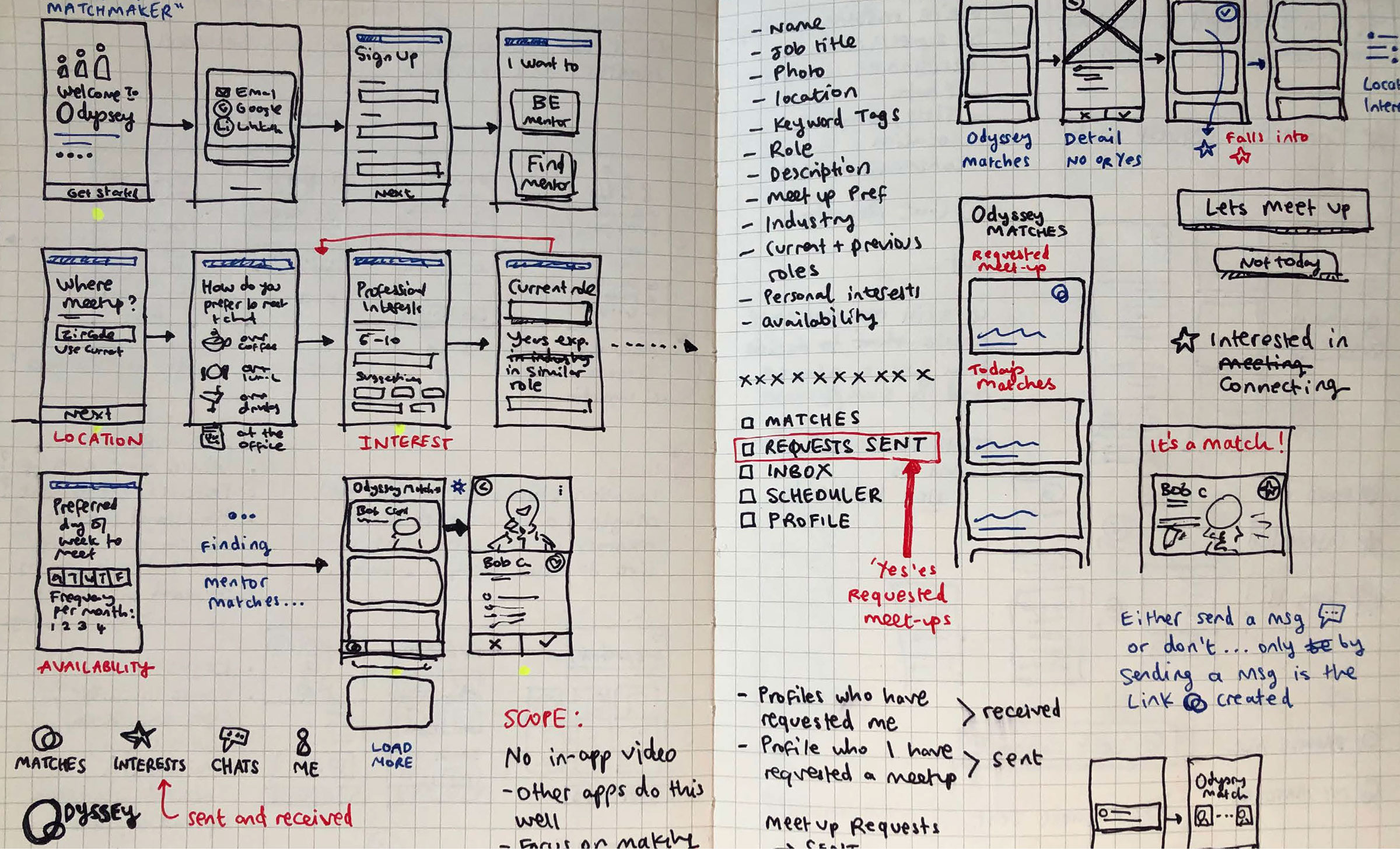
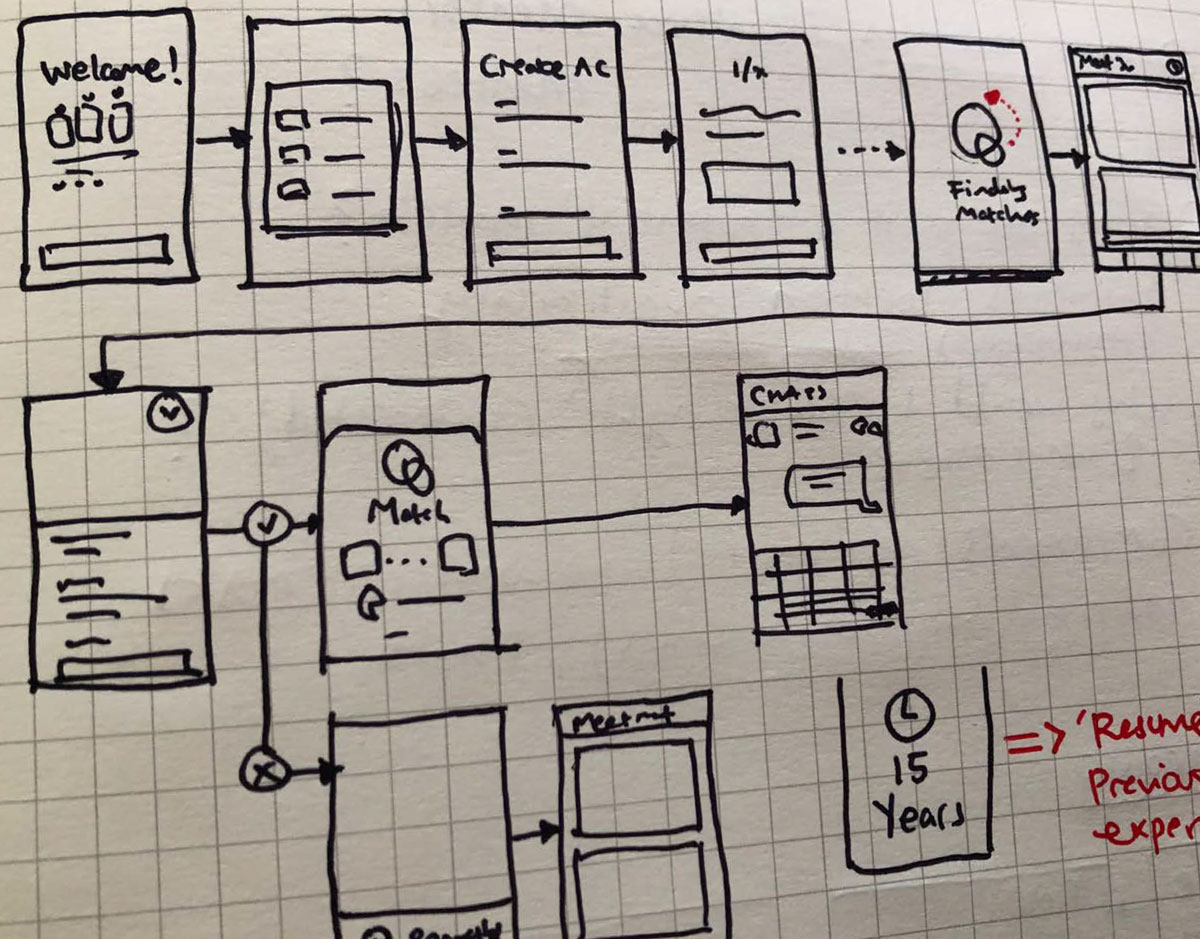
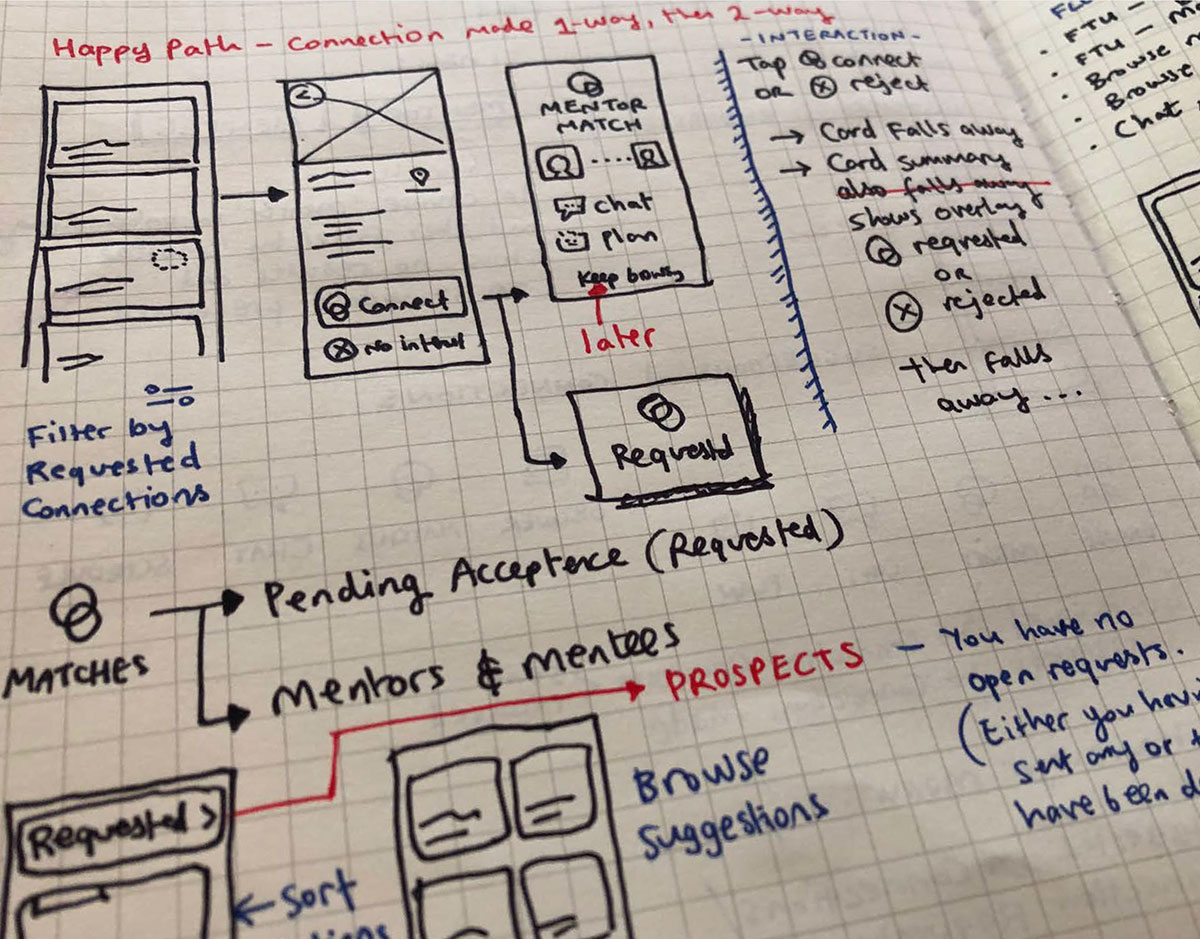
LoFi Whiteboarding
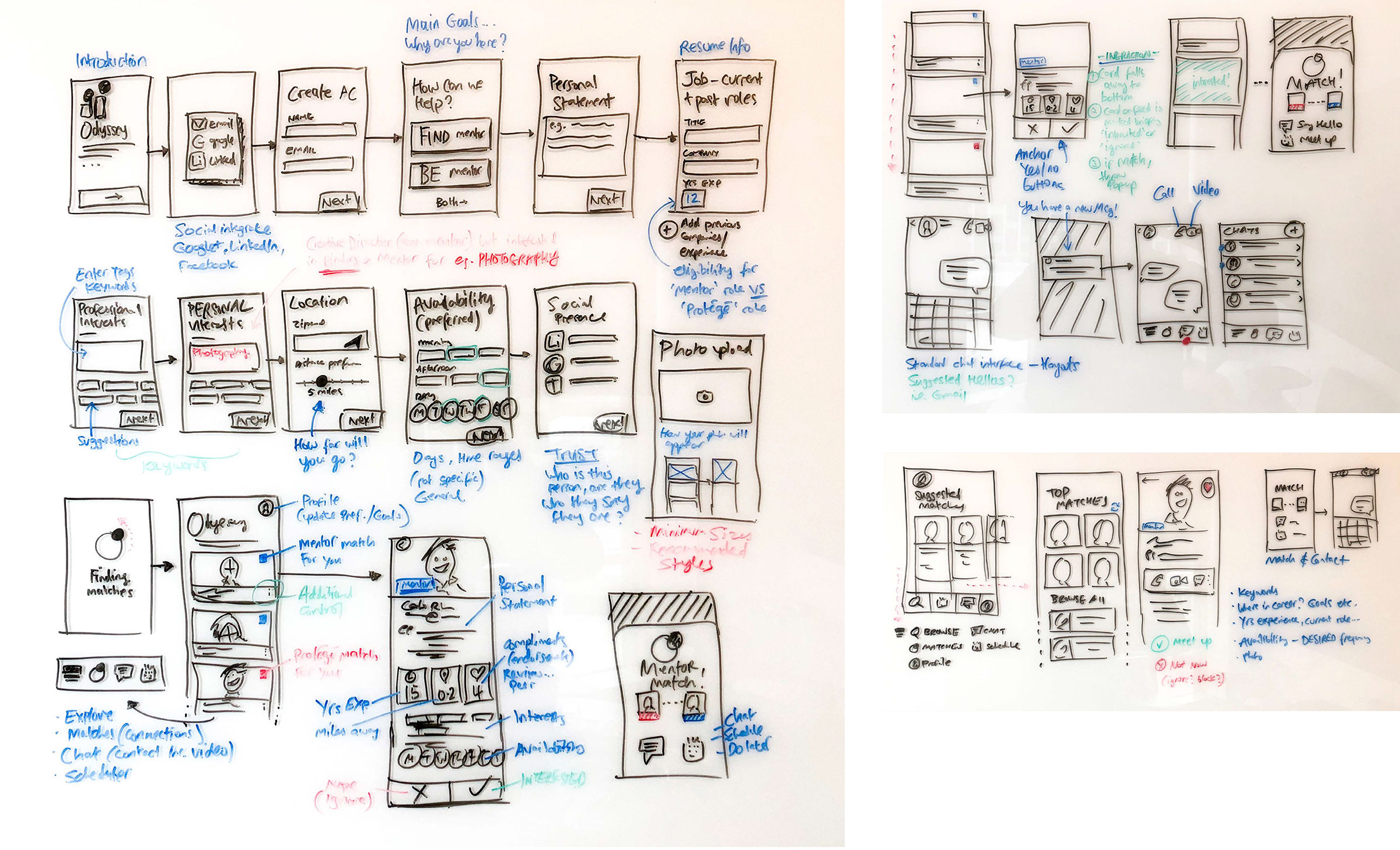
LoFi Wires: First Time User Flow
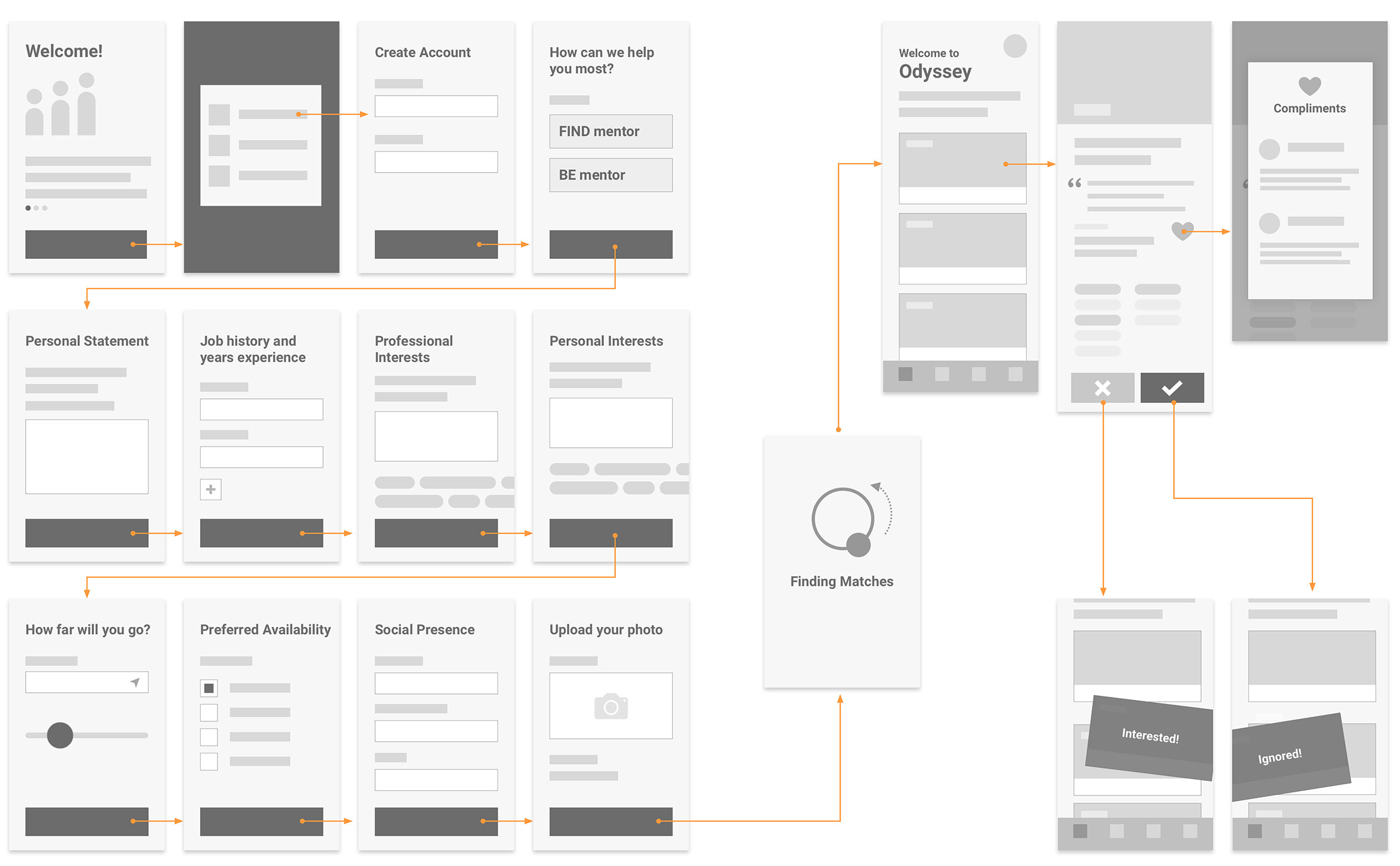
LoFi Wires: Return User Matching
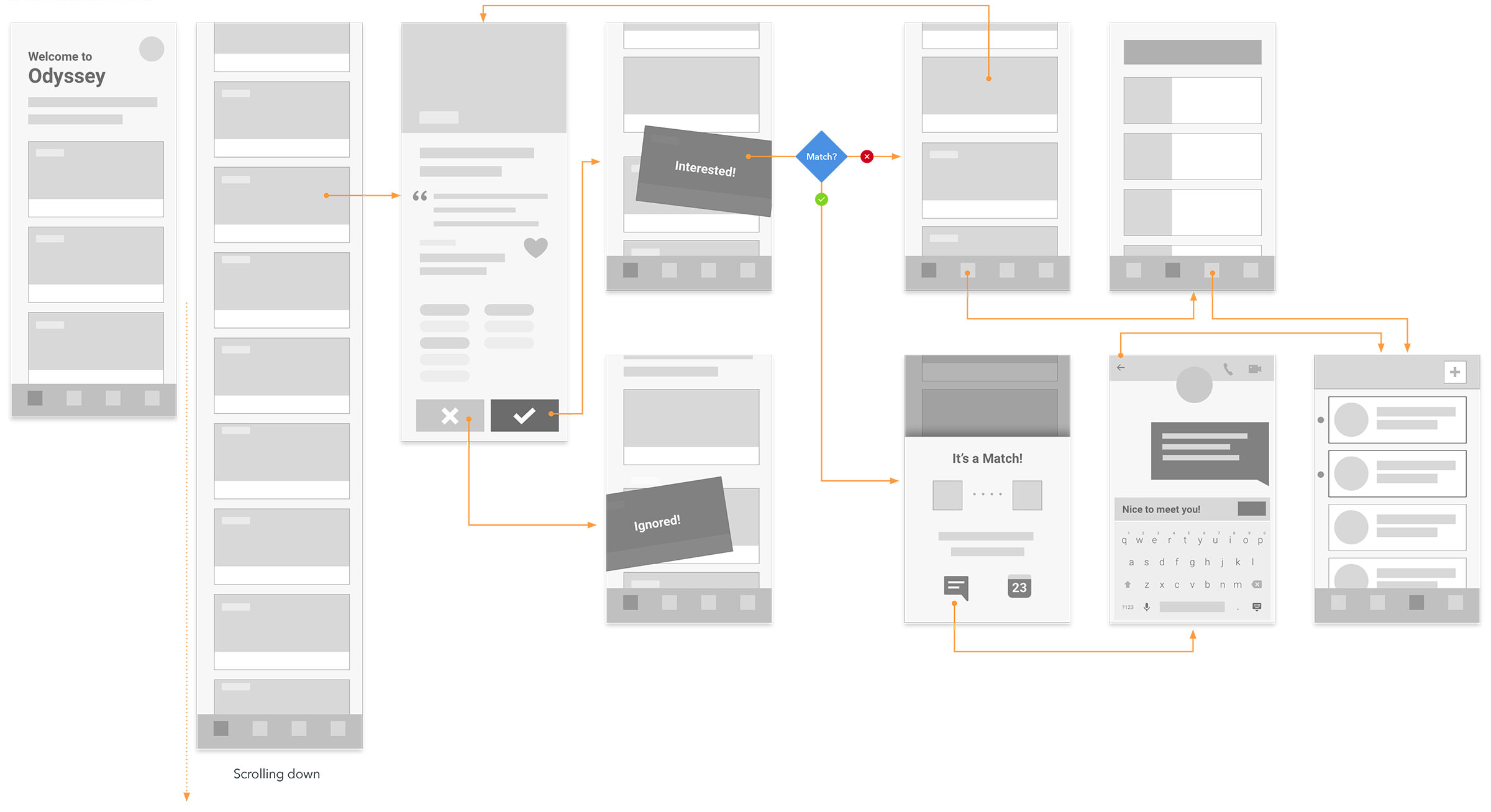
HiFi Wireframes
Detailed, annotated wireframes play a critical role in ensuring product excellence following the design-to-engineering hand-off.
Onboarding
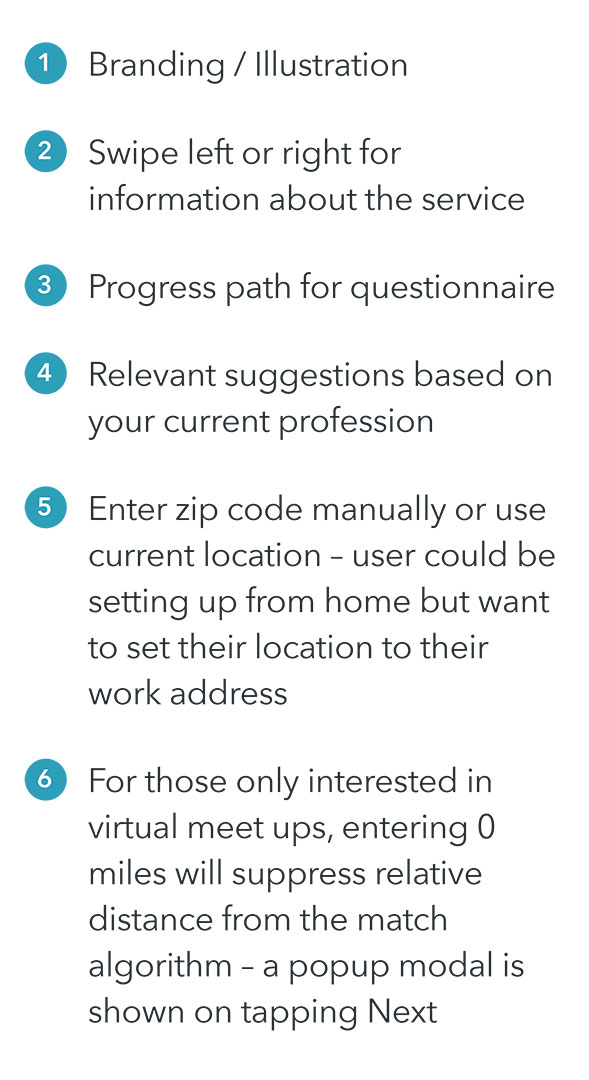
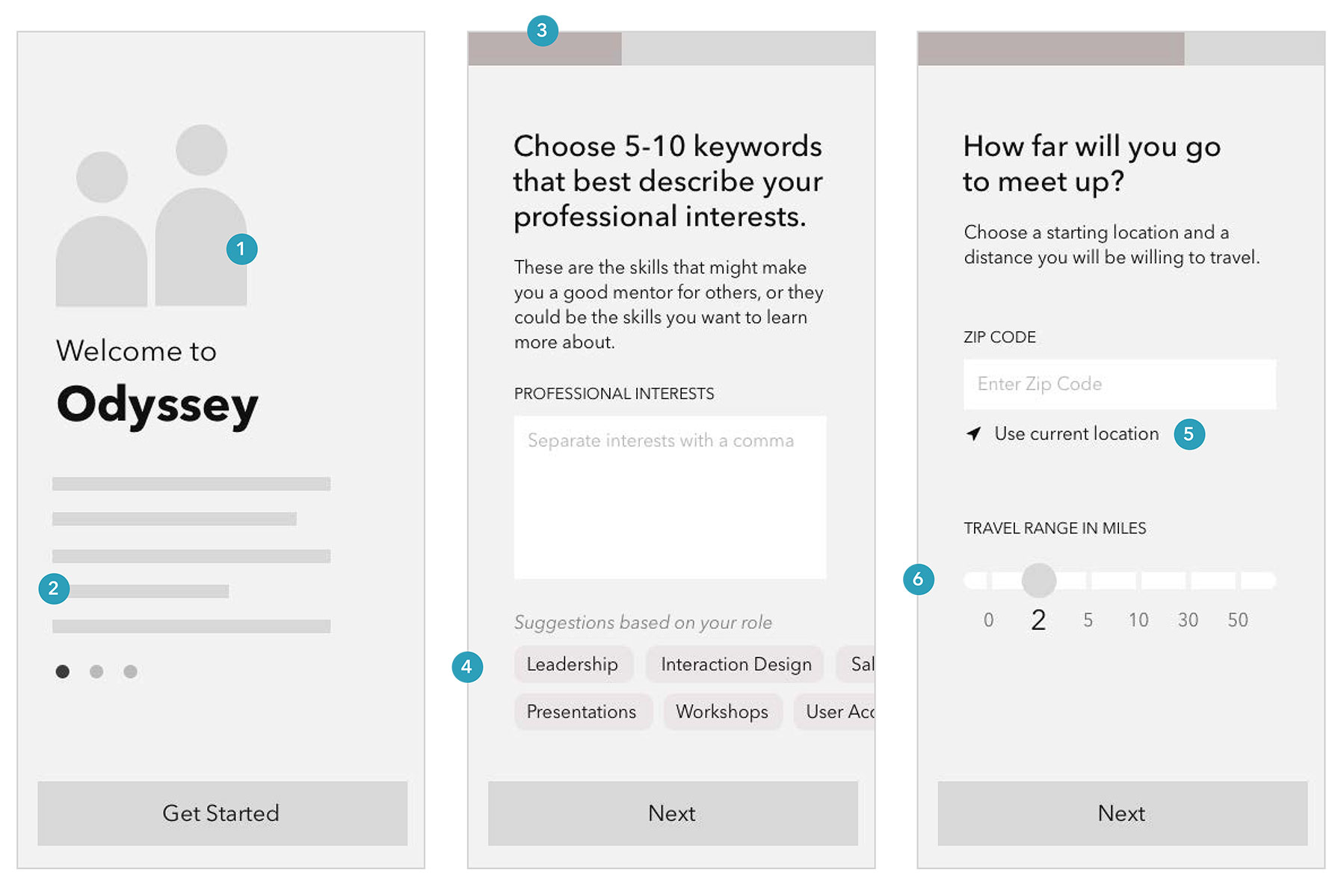
Exploring Connections
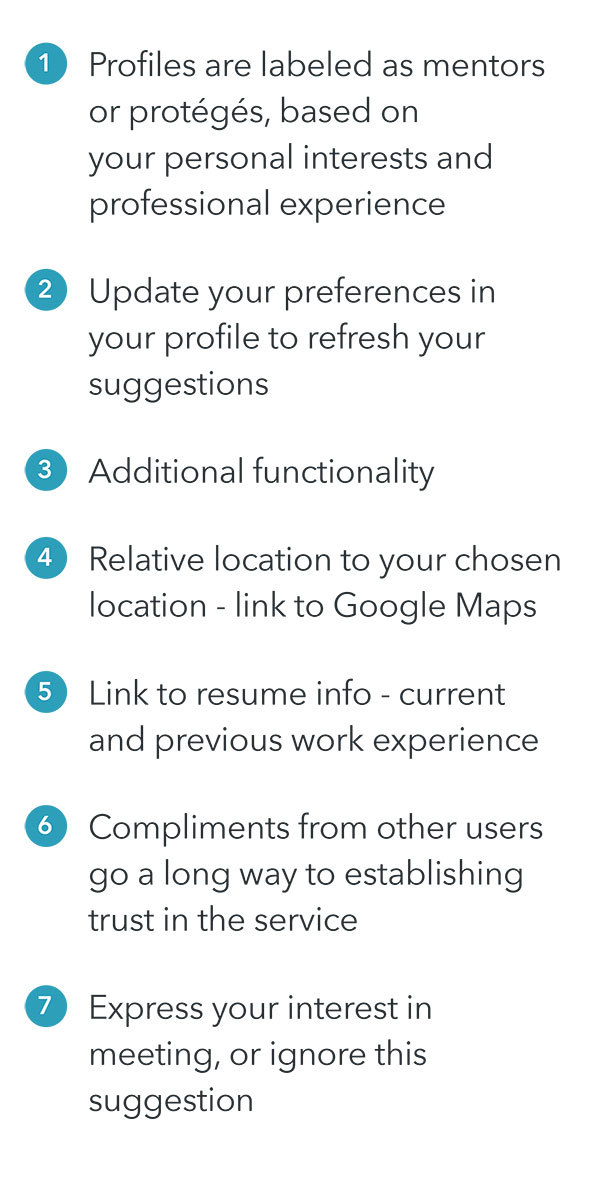
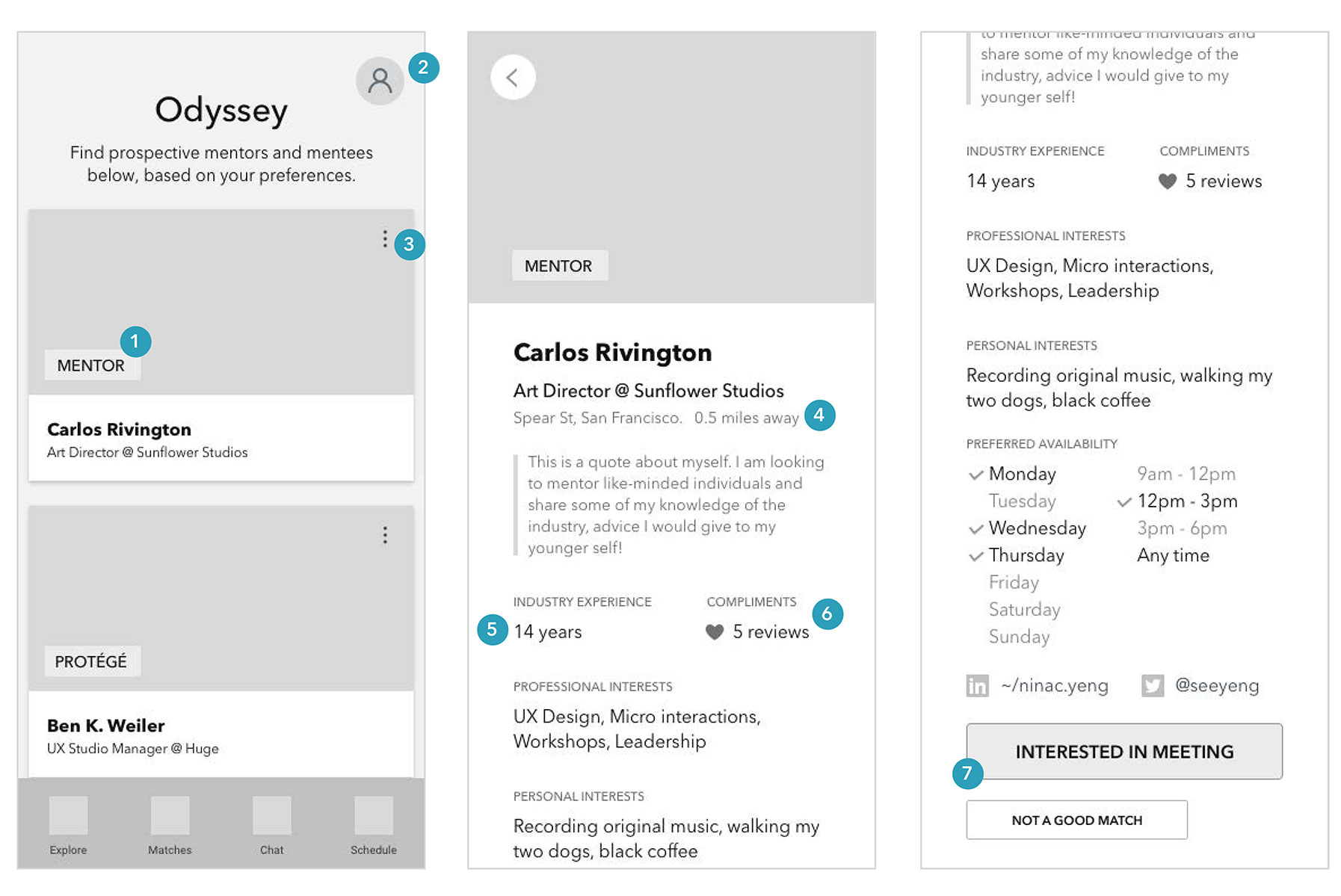
Matching and Contact
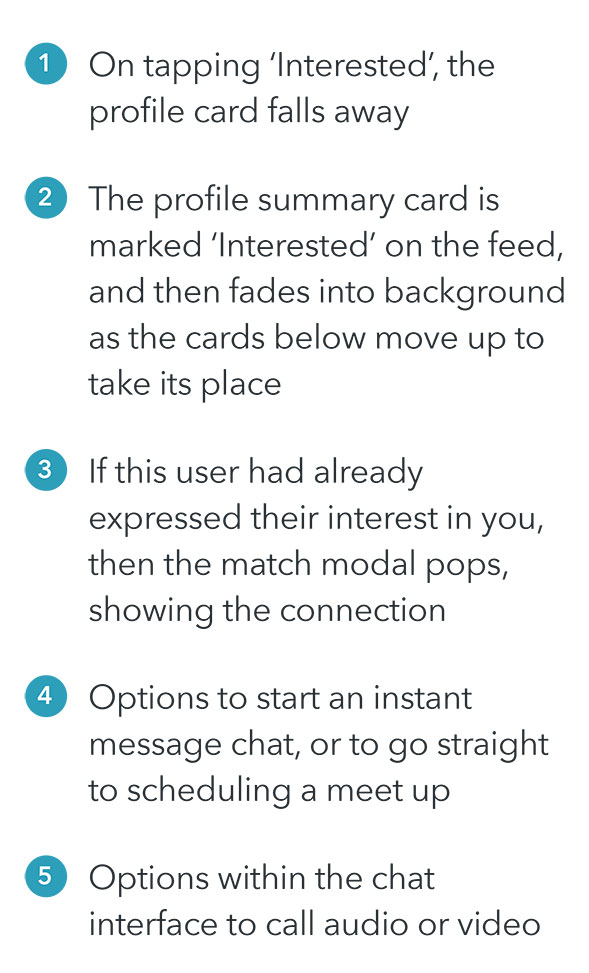
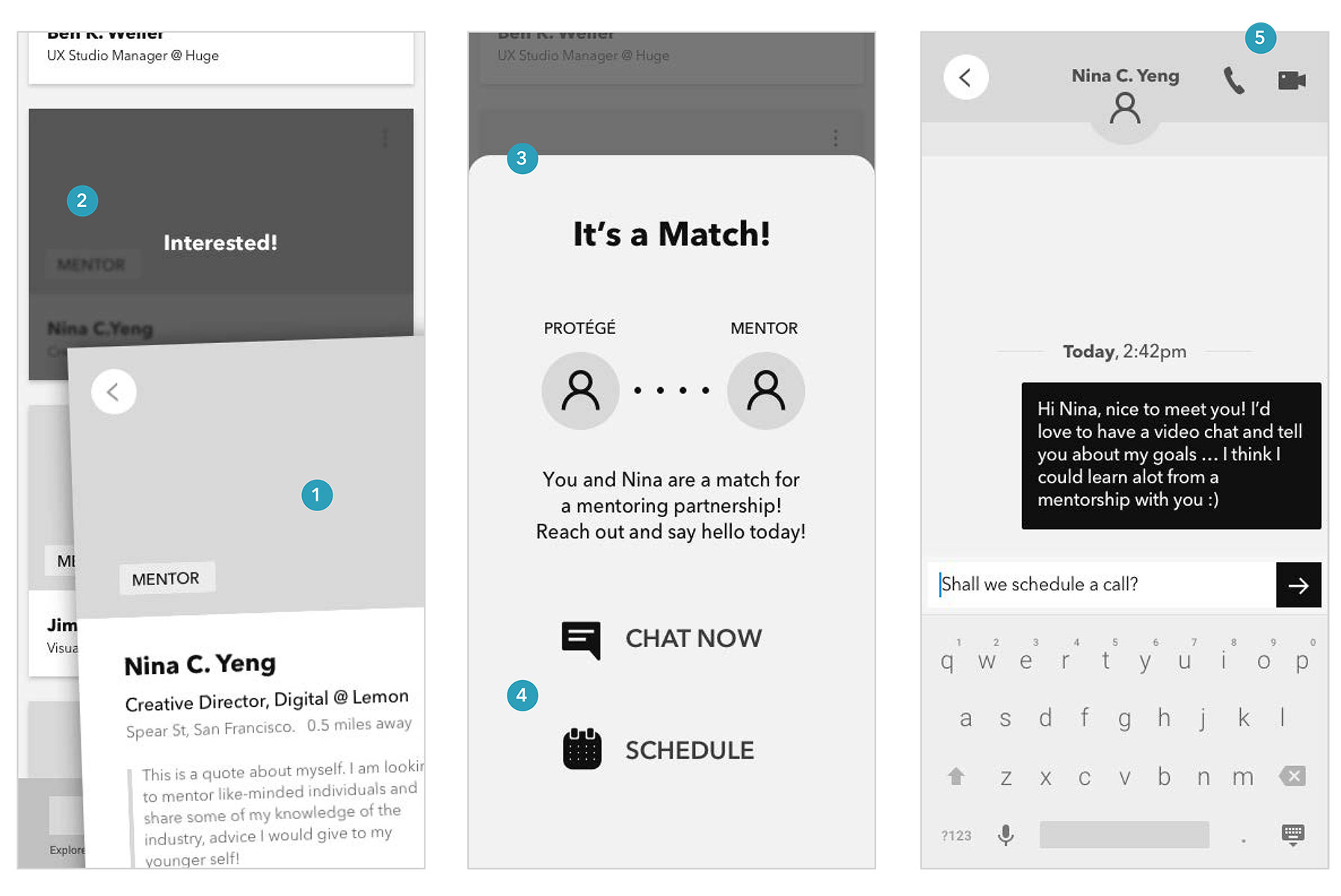
Final Designs
Below are the final, polished designs for Odyssey: The Mentor Matchmaker.
Exploring Connections
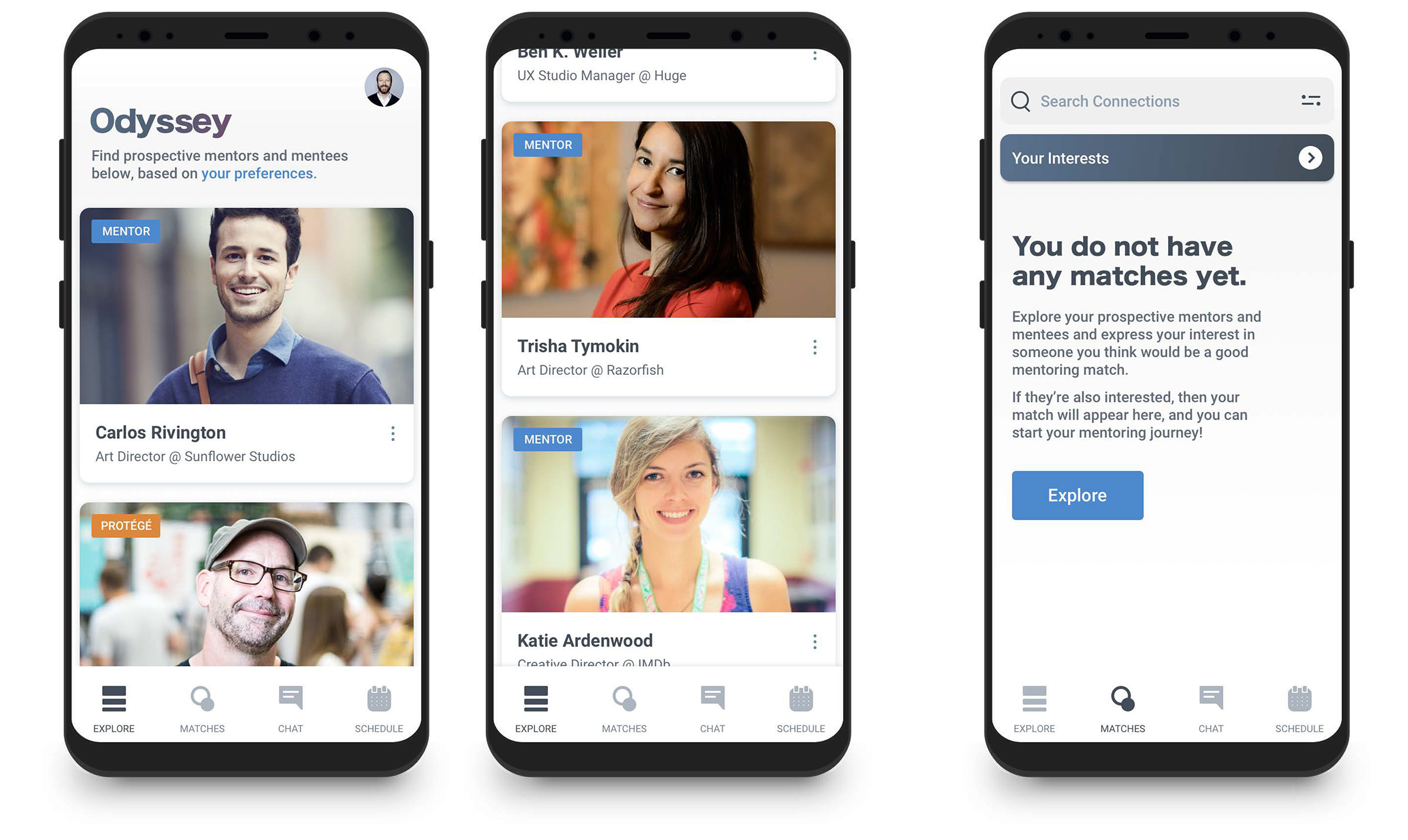
Profile Details
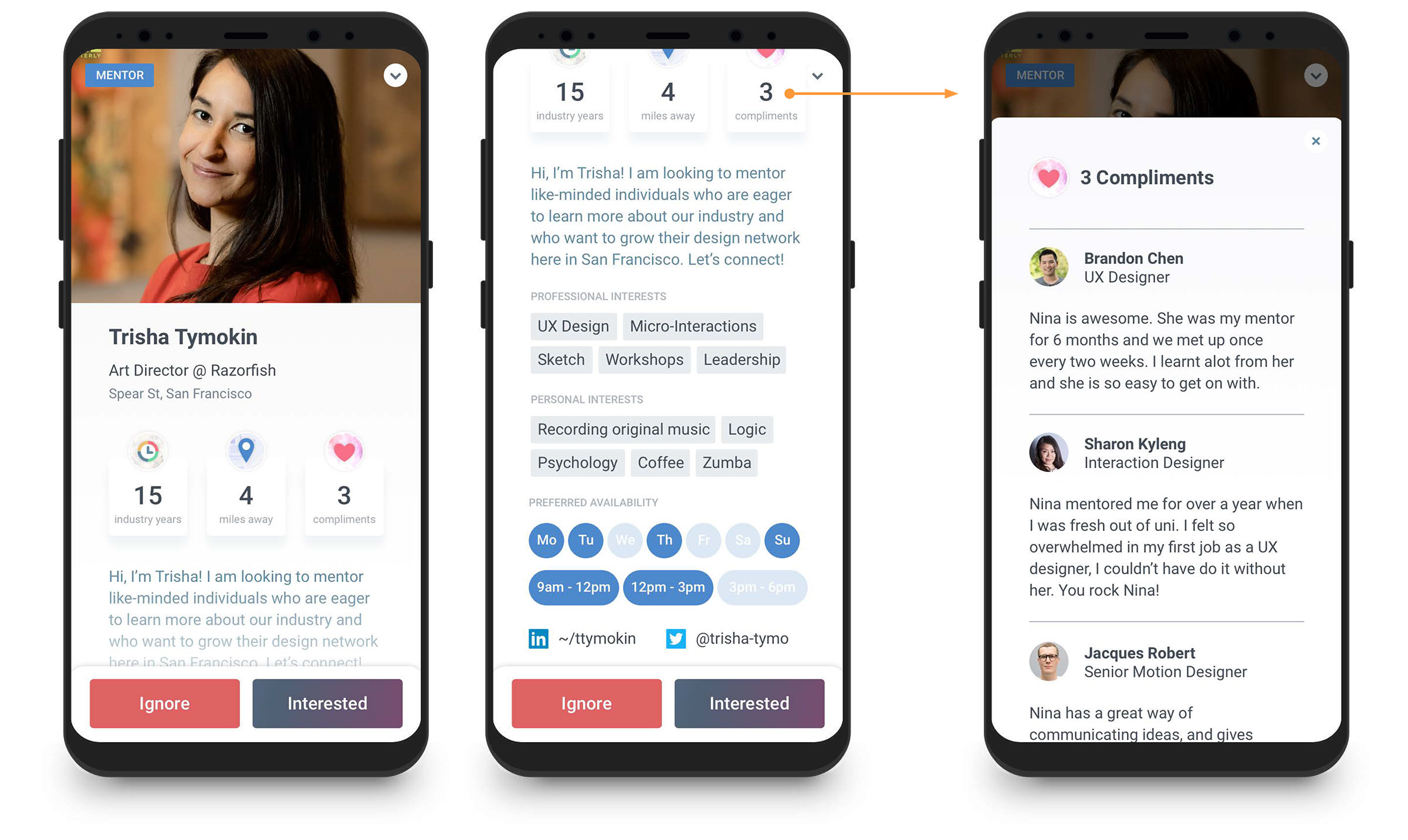
Ignoring A Profile
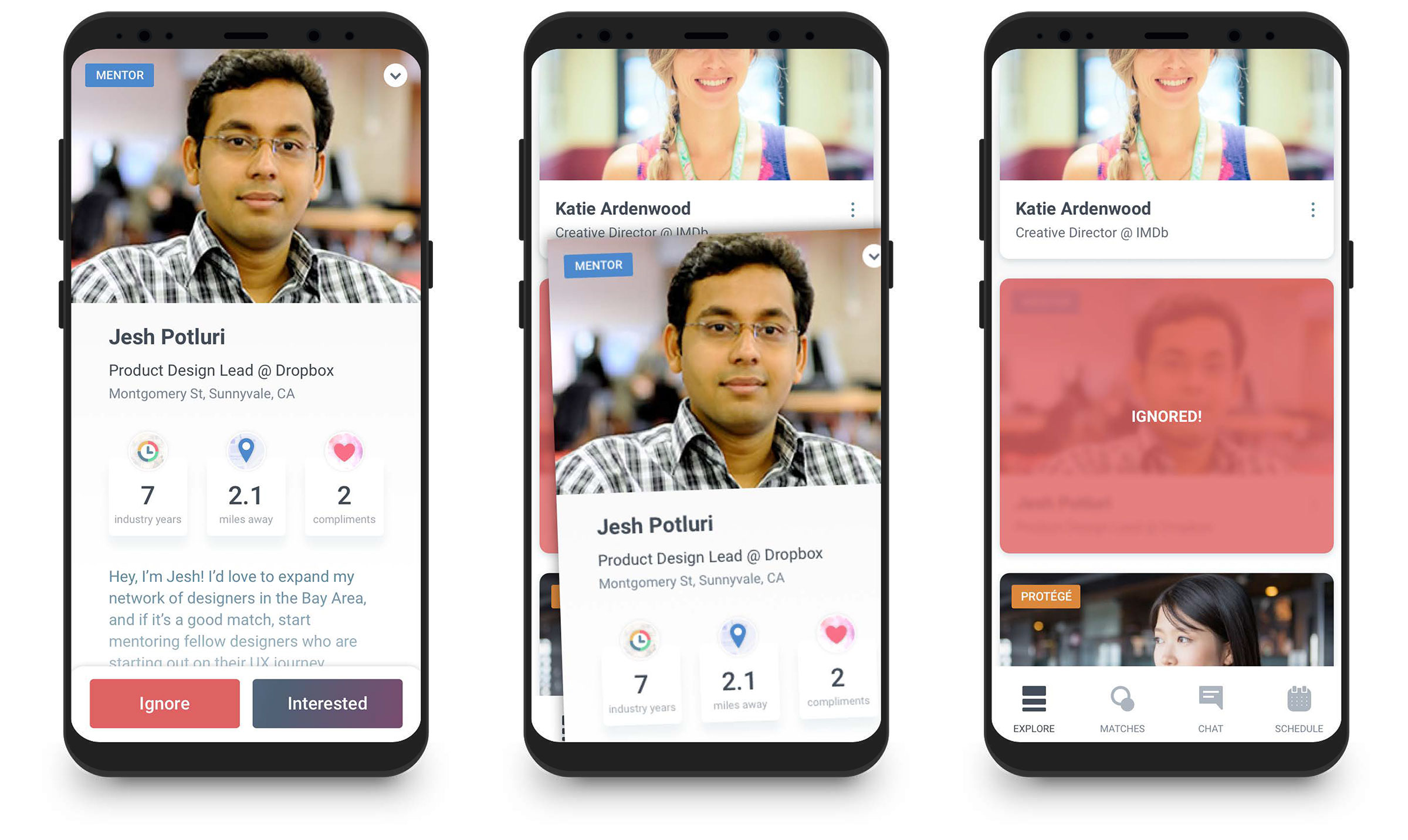
Expressing Interest
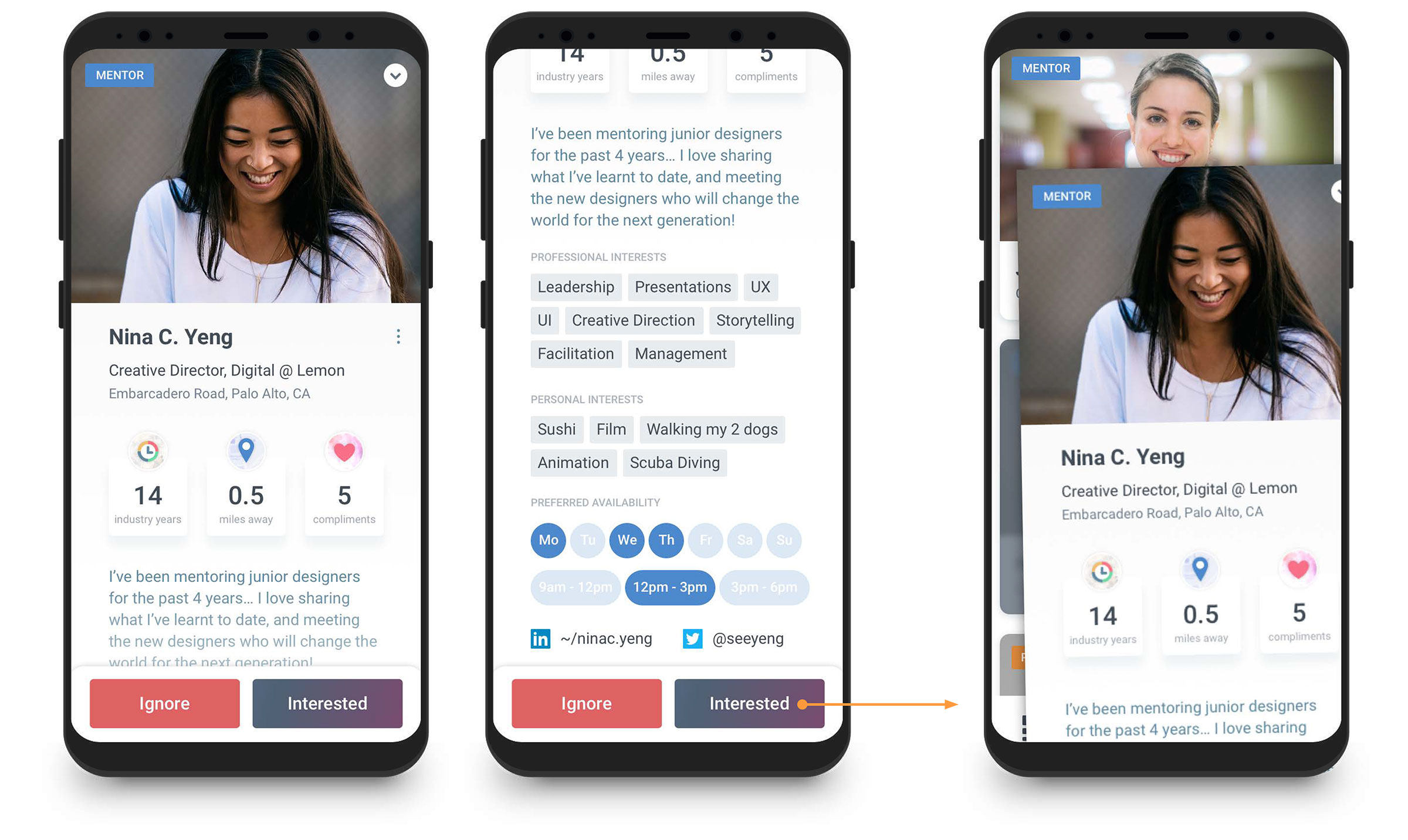
It's an Odyssey Match!
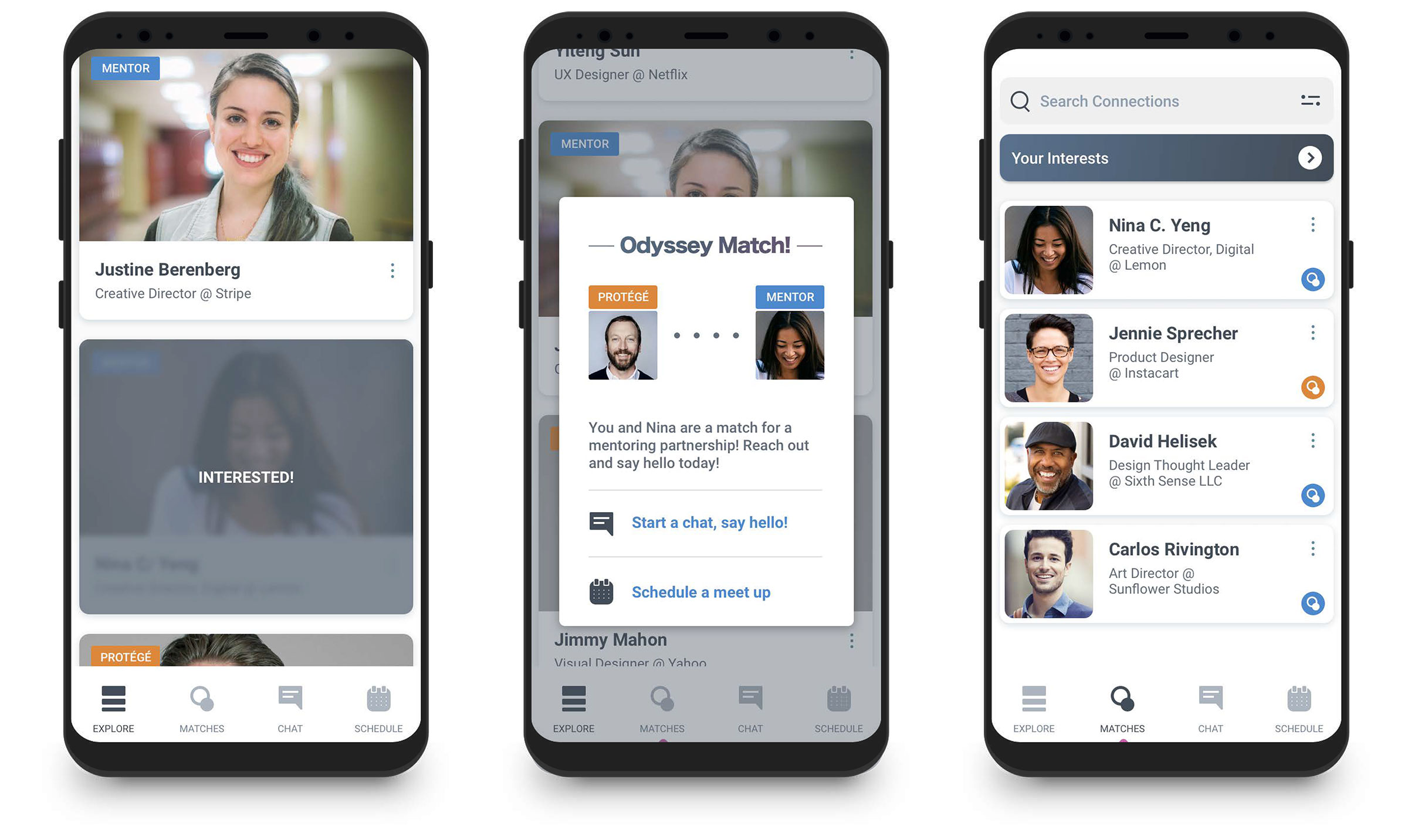
Reflections
This case study demonstrates my design thinking process that I follow in understanding and solving problems. It is a user-focused framework, data driven, human led, and can be summarized as follows: Discovery/Immersion, Concept/Ideation (and iteration), Validation Testing, Design and Build. We must never stop learning as we are developing concepts, after we launch the MVP and throughout the life cycle of any product or service. So it’s worth noting that missing from this particular case study is the Validation Testing phase. This phase involves low fidelity mocks, early flows and rapid prototypes used in individual or group research sessions, interactive workshops and online user testing modules to inform my iterate-validate-repeat process. If designing this experience for real, these feedback loops would be crucial in validating the concept and refining the user flows, architecture and detailed visual designs.
Scope of the challenge
I didn’t go into any detail around the chat/video interface or flows, as I felt they would be similar to much of what exists already today, and could in fact directly leverage existing products like Hangouts and Duo. Scheduling a meeting is also absent from this design, as I was focused on the matching part of the experience and not what happens next; but having effortless scheduling would certainly be next on my list. Another constraint I put on this design solution was removing any financial payments from the experience. If mentors are not incentivized financially to engage, then what is the transaction, and what is the reward for mentoring? Exploring this question led me towards the idea of symbiosis, and ultimately to my final proposal.
Future Improvements
This MVP design focuses on the match and making the initial connection, but not so much on nurturing the connection. Feature ideas for future releases include: Post-connection, defining specific mentor-protégé goals; Setting and completing tasks; Feedback loops, progress trackers; Rewards/points/badges; Gamification; Mentoring groups.



